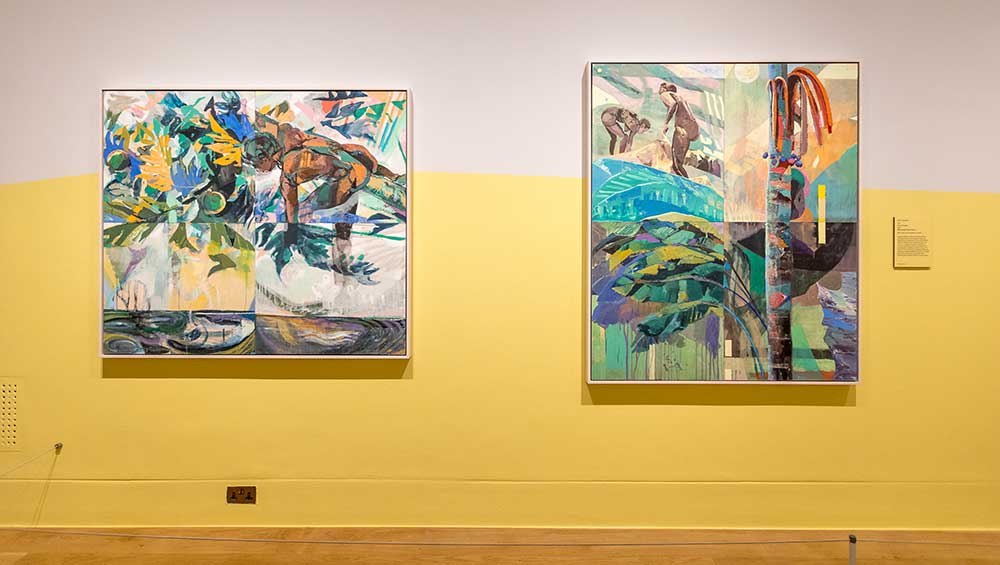
Soulscapes, installation view, Dulwich Picture Gallery, London, 14 February – 2 June 2024. Image courtesy Dulwich Picture Gallery.
Dulwich Picture Gallery, London
14 February – 2 June 2024
by DAVID TRIGG
Landscape has a long trajectory in the history of art, and the natural world remains a perennial source of inspiration for contemporary artists. Soulscapes, at the Dulwich Picture Gallery, examines the genre through the eyes of 21 international artists from the African diaspora, considering the different ways that identity and collective history impact individuals’ relationships with the environment. Traditional notions of landscape art are challenged throughout the exhibition, which offers a range of alternative and sometimes provocative perspectives.
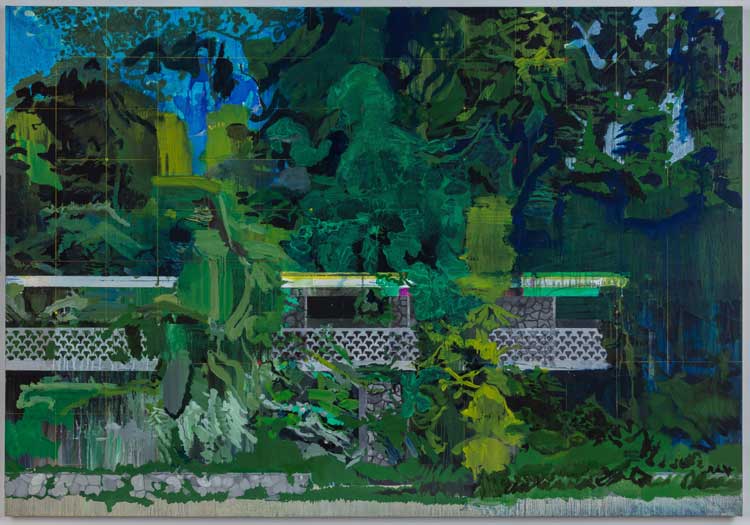
Hurvin Anderson, Limestone Wall, 2020. © Hurvin Anderson. Courtesy the artist and Thomas Dane Gallery. Photo: Richard Ivey.
Though Soulscapes is not a painting show, the medium dominates, and when the bar is set so high by Hurvin Anderson in the first room, expectations begin to soar. Few canvases, however, match the brilliance of the British artist’s Limestone Wall (2020), a verdant landscape from his Jamaican Hotel Series, in which abandoned concrete architecture is engulfed by lush swathes of Caribbean vegetation. Painted with rich, sensuous colours and fluid brushwork, it is animated as much by memory, imagination and personal heritage as observation – a true soulscape, where fact and feeling collide.
Another large dose of imagination is injected by Michael Armitage, whose intriguing composition Anthill (2017) references Tanzanian myths about witches flying out of anthills on the backs of hyenas. Instead of canvas, he has painted on to highly textured lubugo cloth, a material sourced from mutuba trees in Uganda, the wrinkles, clefts and undulations of which become a part of the fantastical image. Fantasy also pervades three circular paintings by Alberta Whittle, whose work is motivated by the legacies of transatlantic slavery and racial injustice. These watery scenes appear like fairytale illustrations, each one depicting a black figure seemingly submerged at the bottom of the ocean. In this they evoke the myth of Drexciya, so eloquently explored by Ellen Gallagher, whose work is not included.
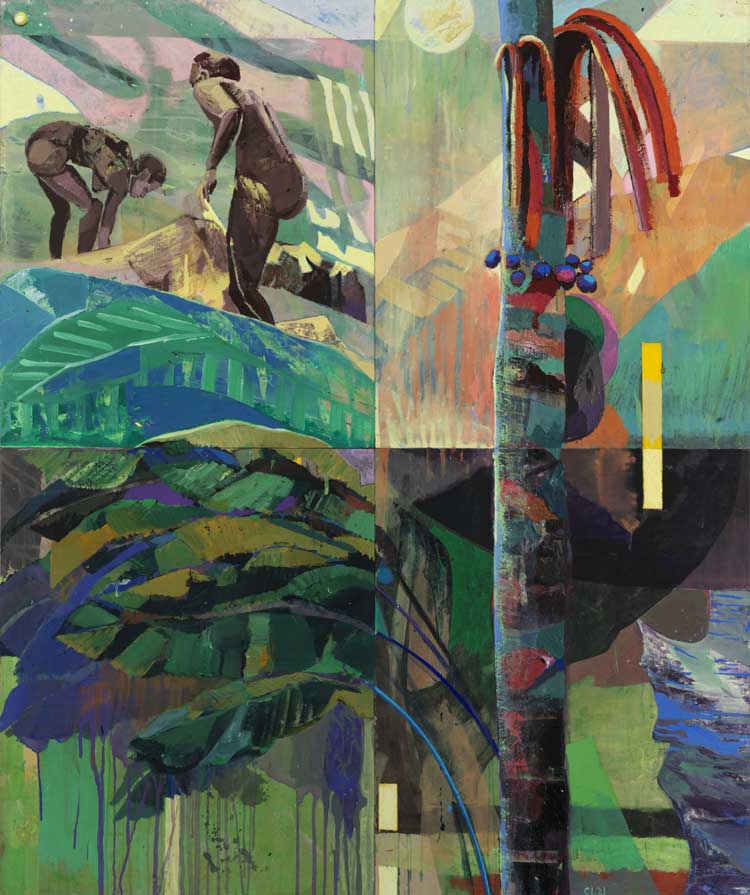
Che Lovelace, Moonlight Searchers, 2022. Acrylic and dry pigment on board panels, private collection. Courtesy of the artist, Corvi-Mora, Various Small Fires and Nicola Vassell Gallery.
The black figure in the natural world is a recurring theme. Christina Kimeze’s dreamlike Wader (Lido Beach) (2022) depicts a lone pregnant woman in silhouette, waist deep in a pond alive with radiant colour and texture, though as with other large-scale works here, the enormous composition hangs uncomfortably in the modestly sized gallery. Elsewhere, Che Lovelace’s admirable canvases depicting women in Trinidadian landscapes are masterfully balanced, exuding a satisfying sense of harmony and equilibrium.
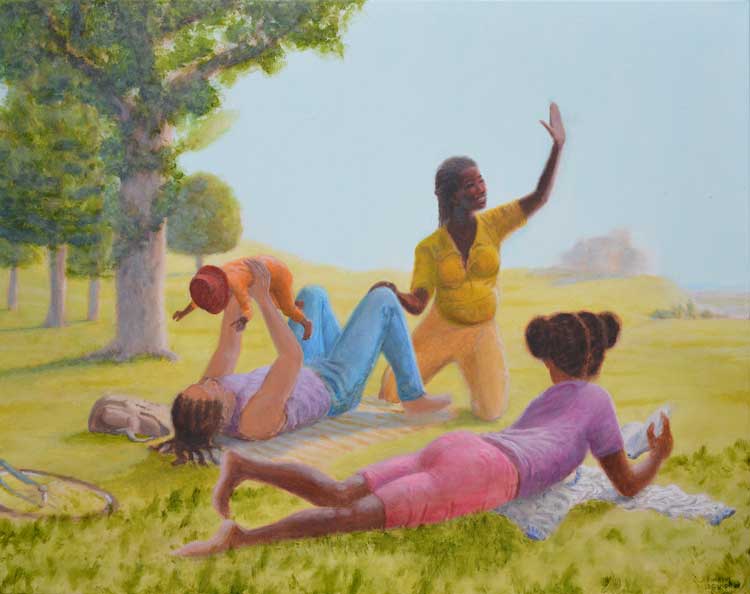
Kimathi Donkor, On Episode Seven, 2020. Acrylic on canvas, 61 x 76 cm Courtesy of the Artist and Niru Ratnam, London. Photo: Kimathi Donkor.
A group of four paintings by Kimathi Donkor, from his ongoing Idyll series, depict adults and children relaxing in saccharine, greetings-card landscapes. The wall label informs us that these are expressions of “Black joy”, which “is also a form of resistance against being excluded, silenced or classed as victims”. Yet, there is a disjuncture here between this radical curatorial language and Donkor’s aesthetically conservative, borderline kitsch compositions.
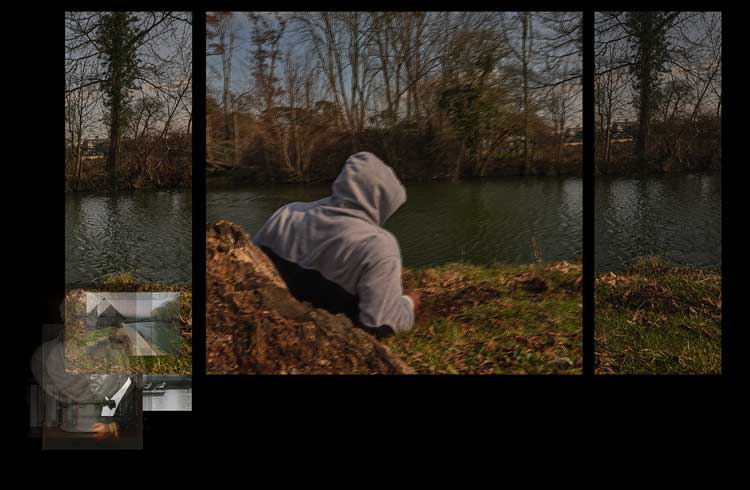
Jermaine Francis, A Pleasant Land J, Samuel Johnson, & the Spectre of Unrecognised Black Figures, 2023. Photographic montage, 130 x 100 cm. Courtesy of Artist Jermaine Francis.
The theme is touched on elsewhere in Jermaine Francis’s photographic diptych A Pleasant Land. J. Samuel Johnson, & the Spectre of Unrecognised Black Figures (2023), which speaks to the historical presence of black people in the English landscape but who, because of the absence of interest in recording information about their lives, are unknown to us. However, this potentially rich vein of inquiry is not pursued further. Why not include Ingrid Pollard? Or the young British-Ghanaian artist Tanoa Sasraku? Both these artists have critically challenged the assumption that white people more naturally belong to Britain’s countryside in ways that feel far more urgent.

Mónica de Miranda, Sun rise (detail), 2023. Inkjet print on cotton paper. Courtesy of the artist and Sabrina Amrani Gallery, Madrid.
Besides the glut of painting are meditative photographs by Mónica de Miranda of suited migrants standing amid breaking ocean waves; an intricately layered sculptural collage by Ebony G Patterson, teeming with luscious vegetation, snakes and human hands; an extraordinary embroidery by Kimathi Mafafo, in which a woman emerges from a muslin cocoon into a flourishing landscape; and a large-scale mixed media collage by Njideka Akunyili Crosby, in which the broad leaves of a cassava plant are layered with imagery from fashion magazines, pictures of Nigerian pop stars, and childhood photographs. The collage draws inspiration from the Los Angeles-based artist’s childhood trips to her homeland of Nigeria, where she remembers encountering the woody cassavas. Here, landscape is inferred; a memory embodied in a houseplant.
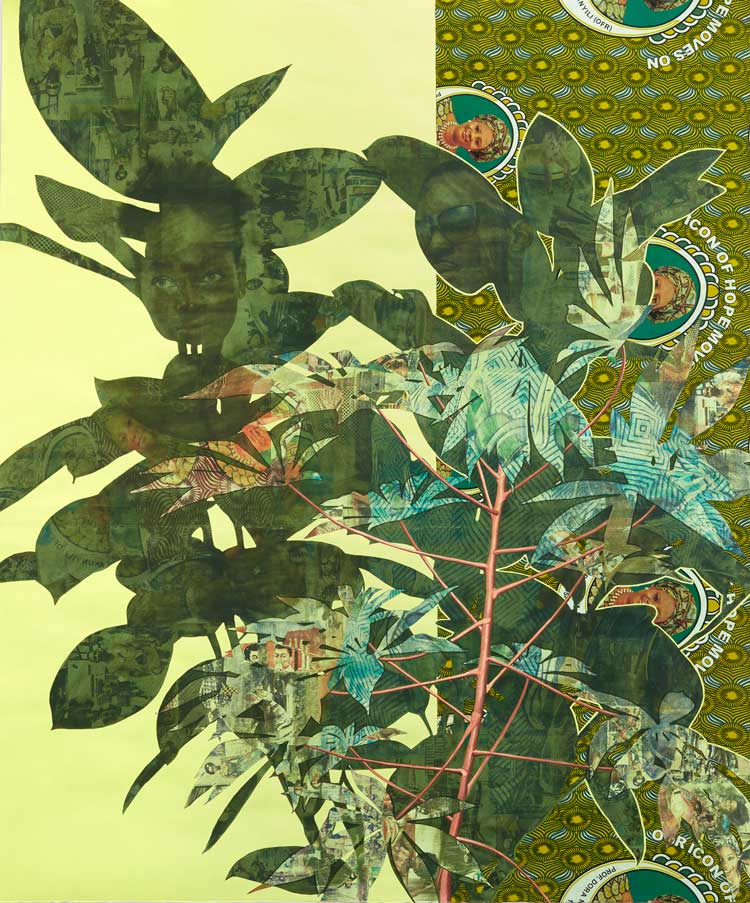
Njideka Akunyili Crosby, Cassava Garden, 2015. Acrylic, transfers, colour pencil, charcoal and commemorative fabric on paper, 182.8 x 152.4 cm © Njideka Akunyili Crosby. Courtesy the artist, Victoria Miro, and David Zwirner. Photo: Robert Glowacki.
Finding it hard to compete with this overload of visual dynamism is Harold Offeh’s video Body Landscape Memory. Symphonic Variations on an African Air, Op 63 (2019), in which anonymous black figures pose in rural landscapes, contemplating nature. Intended as a counter to stereotypical depictions of the labouring or victimised black body, the work foregrounds leisure and play, and is set to a piece of music by the early 20th-century black classical composer Samuel Coleridge-Taylor, which attempts to evoke the landscape of Africa despite him never having travelled there. The lively sounds fill the gallery, providing an apt soundtrack, though the slow-paced video is something of a longueur.
Soulscapes, while patchy, has flashes of brilliance. Another standout is Phoebe Boswell’s video installation I Dream of a Home I Cannot Know (2019), which plays in the atmospheric, yellow-tinged environment of the gallery’s mausoleum. This quirky space is the perfect home for this piece, which comprises layered footage of fisherman and others at work and play on a sun-drenched Zanzibar beach. Though an idyllic scene unfolds on-screen, in the funerary atmosphere of this space, the imagery seems tinged with melancholy – a subtle tension that, as with the best works here, keeps you transfixed on distant terrain.